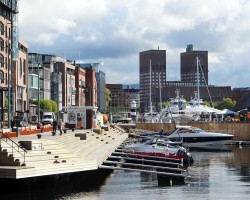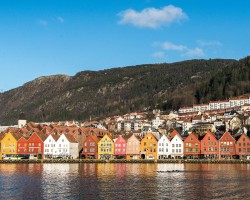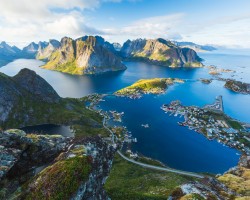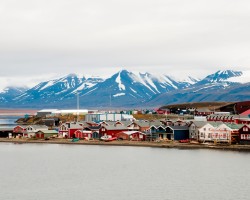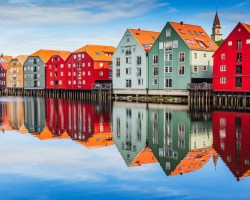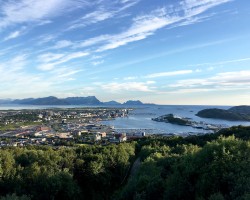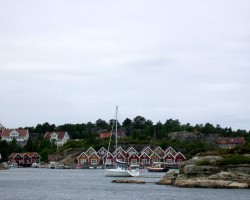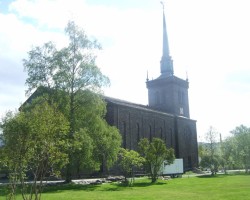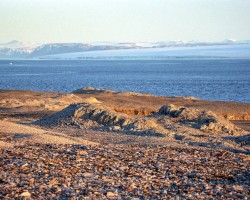Best time to go to Norway for a perfect weather and where to go?
When is the best time to go to Norway?
The ideal period to visit Norway from a climatic point of view is July-August, but the period that extends more broadly from May to September can also be considered for a discovery trip.
Very brief, spring is marked by the melting of snow and the awakening of nature after long months of dormancy. It is at this time that many hiking trails reopen to the public and that cruises between the fjords are magical with fruit trees in bloom and landscapes, each more breathtaking than the other.
Depending on the latitude, it is possible to see the midnight sun between late April and late July. If you go to regions beyond the Arctic Circle, you can observe it in all its splendor, when the lowest point of the sun does not disappear behind the horizon. Further south, even if the phenomenon is not total, you can enjoy very long days and almost non-existent nights.
The peak tourist season corresponds to the period between mid-June and mid-August. The weather can be very nice, even hot in the south of the country, and it is the perfect time for hiking in Norway's stunning natural spaces. However, it should be noted that the weather can change at any moment and the atmosphere can quickly become cool and humid. Indeed, rain is an integral part of Norway's uncertainties and it is essential to be properly equipped, even in the middle of summer!
Autumn arrives quickly, as early as the end of August, and lasts until October. It is still a good season for walking, especially since the landscapes display flamboyant colors. In September, temperatures are still pleasant and rain is less present than in summer.
When is the best time to visit Norway to see the Northern Lights? In the most northern regions, they are visible from late September, but you will have much better chances of observing this fascinating phenomenon when the nights are long, so during the winter months.
Apart from the Northern Lights, the reasons for the influx of tourists in winter are numerous: for example, you can ski down the slopes of the superb ski resorts, but also discover northern Norway by dog sledding. For this, make sure to plan your trip well, as public transportation is scarce and most accommodation centers remain closed.
If you go beyond the Arctic Circle, between mid-November and late January, the sun does not rise at all, this is what is called the polar night. You will only benefit from a slight brightness from around 10 am to 1 pm. Elsewhere, the sun is present only a few hours a day, so it is better to prefer the end of winter to make the most of it.
Where and when to go based on the weather?
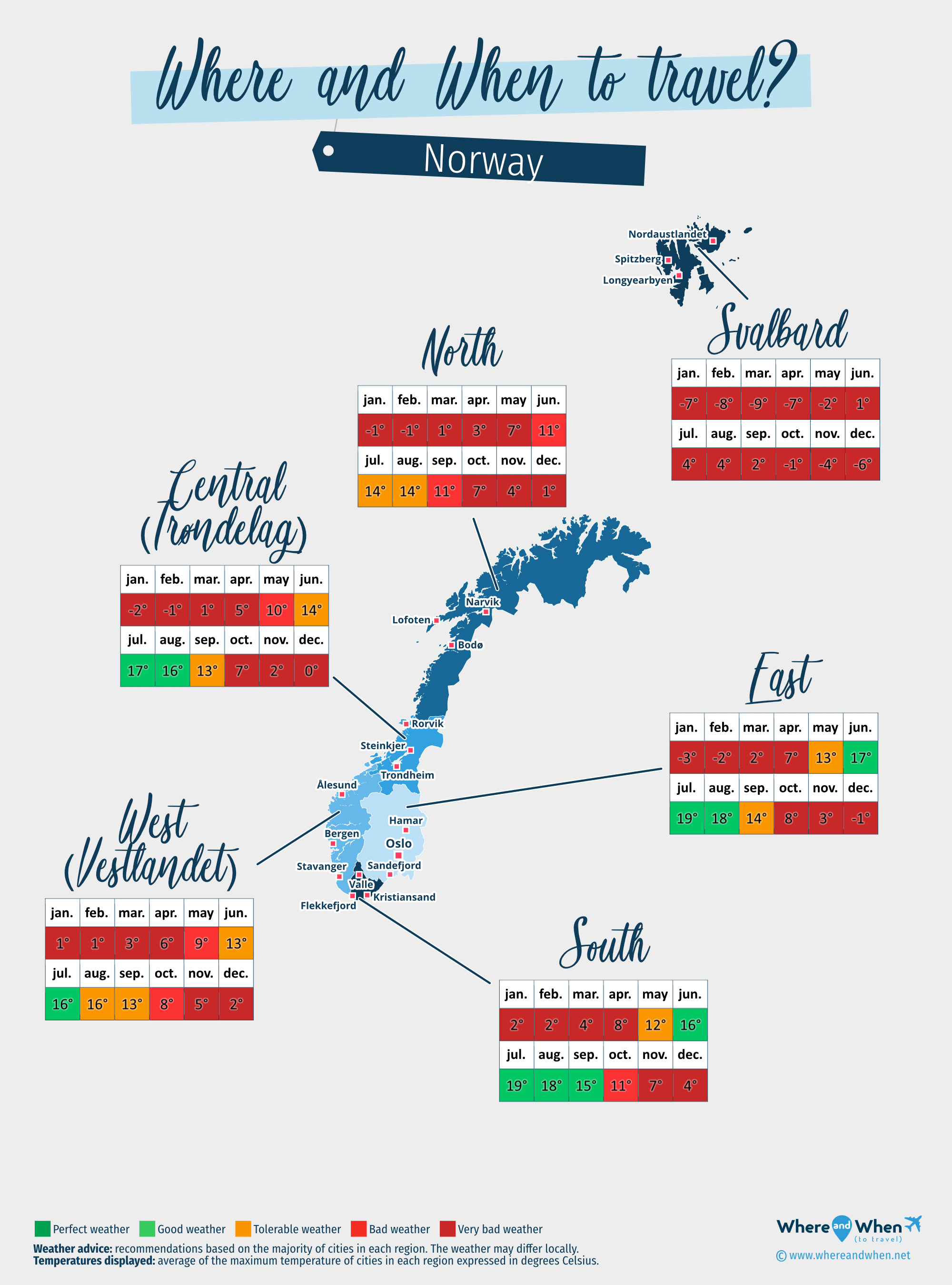
Central (Trøndelag)
Trondheim, Steinkjer, Rorvik...
East
Oslo, Sandefjord, Hamar...
North of Norway
Lofoten, Narvik, Bodø...
South
Kristiansand, Flekkefjord, Valle...
Svalbard
Spitzberg (Svalbard), Longyearbyen, Nordaustlandet...
West (Vestlandet)
Bergen, Stavanger, Ålesund...
To get all the information about the climate and weather in Norway for a specific month, click on the corresponding link below:
Norway in january Norway in february Norway in march Norway in april Norway in may Norway in june Norway in july Norway in august Norway in september Norway in october Norway in november Norway in december
Best time to travel to Norway by cities
Climate and Weather in Norway
Even though the country is located at the same latitude as Alaska or Siberia, the weather in Norway is greatly warmed by the presence of the Gulf Stream, this warm ocean current coming from the Atlantic. However, rain is omnipresent, and while the sun always shows up between showers, the country remains very humid. Generally, the climate in Norway is rather temperate, although one can find huge temperature differences, from -40°C in the east of the country to +30°C in Oslo, the capital. Moreover, rain and wind can quickly lower the temperatures by several degrees in just a few hours. Stretched over more than 1700 km from north to south, Norway experiences strong climatic disparities, and in general, the coastlines are more temperate than the inland areas. Here are the different types of climates found in the country:
- A subarctic climate, characterized by very harsh winters.
- An oceanic climate which is characterized by temperate summers along the southern coast of Norway and by a much shorter and cooler summer season in the north.
- A humid continental climate with mild summers and winters, but with rain present throughout the year.
- A polar tundra climate in the extreme north of the country.
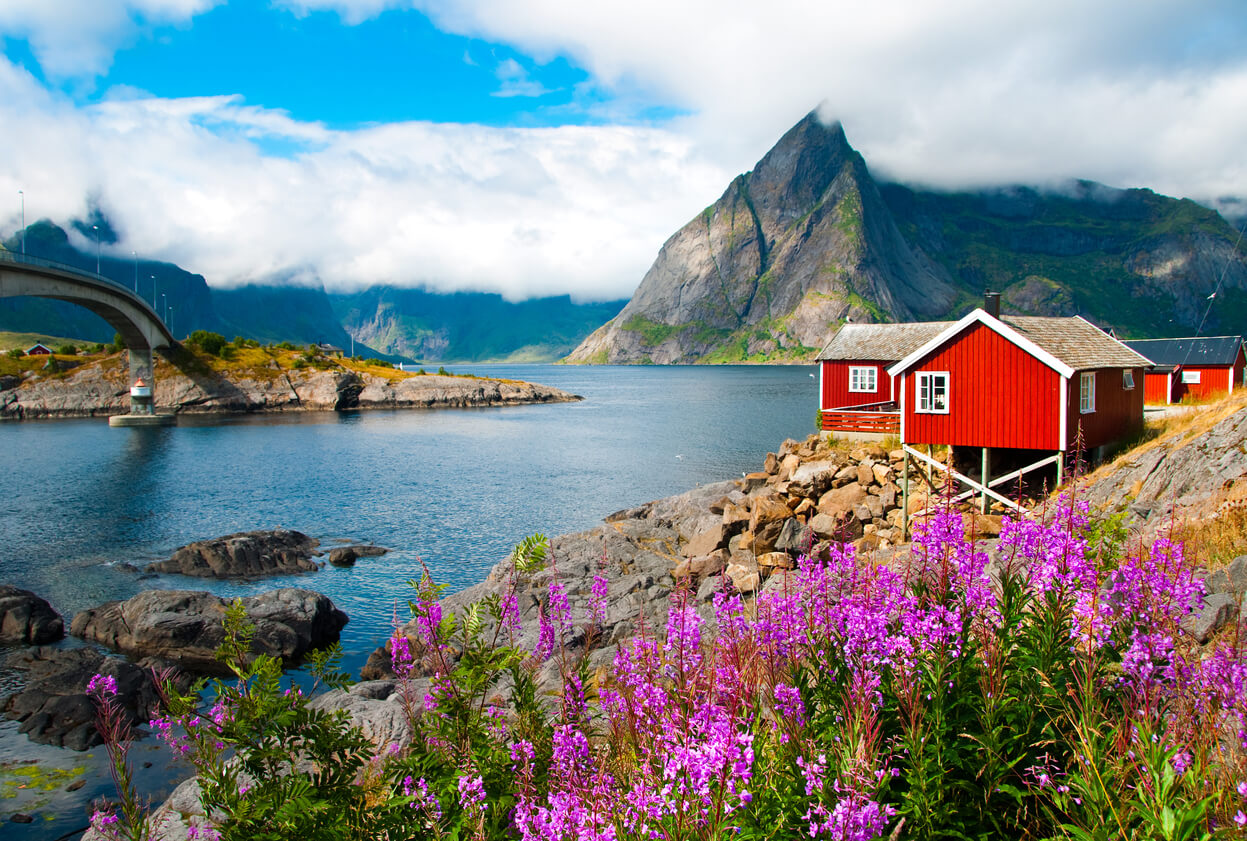
Climate in Southern Norway
It is in the southern tip of Norway that we find the national record for daily sunshine, especially noticeable during the summer. Indeed, between late June and early August, the weather is warm and sunny. There is little humidity, and the coastal air pleasantly cools the atmosphere.
However, the rest of the year is more humid, especially in spring and autumn, when the weather is more unstable, similar to Gothenburg in neighboring Sweden.
Along the coast, for example around Kristiansand, the climate is oceanic, whereas as one moves inland towards Valle, it becomes more subarctic with biting cold, not to mention the not uncommon snowstorms. For the best weather conditions, the ideal time to visit this region of Sørlandet is between June and September.
Climate in Eastern Norway
Corresponding to the region of Østlandet, this part of Norway experiences four distinct seasons and significant differences between the north and the south. Along the coasts, especially around Oslo and its fjord, summers are very pleasant and winters enjoy fairly mild temperatures. Depending on the area, the climate can be humid continental or oceanic, so it's best to pack clothing for all types of weather.
Inland, the subarctic climate is prevalent. Thus, temperatures are largely negative in winter and snow can still fall in spring.
The best months to explore the region are June, July, and August. May is spring, September is autumn, and the rest of the time is winter.
Climate in Western Norway
Vestlandet is the region where the most impressive fjords in the country are found. As mentioned earlier, they benefit from a fairly mild climate due to the presence of the Gulf Stream. Therefore, the prevailing climate in this part of Norway is mainly oceanic, as seen in Bergen or Stavanger.
In winter, it is common for Norwegian fjords not to freeze. On the other hand, rain and wind are often present, so it's not the best time to admire these natural beauties.
The further inland one goes, the more it tends towards a subarctic climate with cold and long winters, as seen in Flåm. In the northern part of the region, towards Ålesund, summers are also very short. July is the ideal month to fully enjoy the beauties of the west.
Climate in Central Norway
The central part of the country experiences the same types of climates as Vestlandet, but being located further north, temperatures are much lower.
Winters are particularly cold and accompanied by heavy snowfall, especially around Trondheim. However, on the coasts, temperatures remain tolerable, although the weather remains humid. In spring, the atmosphere is quite cool until June.
Inland, summers are mild, a season during which the sun never truly sets. Additionally, during this time of year, the atmosphere is not too humid unlike in other months.
Climate in Northern Norway
Although located at the same latitude as Greenland, northern Norway has a milder climate. It is cold, yes, but with a milder climate than in other regions. Indeed, it is rare for the temperature to drop below -5°C, even in the heart of winter. One must go far north, towards the city of Tromsø, to experience quite harsh conditions. Conversely, in the Lofoten Islands, the oceanic climate offers decent temperatures, with only about a ten-degree difference between summer and winter.
The most incredible season is summer, with the midnight sun starting in mid-May and ending by the end of July. It is also the warmest period, especially in July and August.
Another specificity: it is in this part of Norway where a piece of Lapland is found where the sun never rises between mid-November and the end of January, allowing for occasional views of the Northern Lights.
Climate in the Svalbard Archipelago
If you want to experience extreme weather, take a trip to the Svalbard Archipelago! Located between Norway and the North Pole, it has a polar tundra climate.
Winter generally lasts from October to the end of May. During this period, temperatures regularly hover around -30°C and can remain negative for several weeks. Not surprisingly, snowfall is very frequent for much of the year and the sky is often overcast.
In summer, temperatures remain around zero in the north and east of the archipelago. In the south, in the inhabited area of Spitsbergen, the climate is slightly more tolerable, but rain is often present.
Temperatures and rainfall in Norway
On these 3 graphs, we present the evolution of temperatures of Norway and month-by-month rainfall for the cities of Oslo, Bergen, Lofoten, Spitzberg (Svalbard) and Stavanger, as well as the month-by-month sea temperature for coastal cities.
Peak visitor numbers and tourist seasons in Norway
Find out when Norway has its high tourist season (the period when the influx of tourists is highest) and off-peak tourist season using our data and figures.
Tourist seasons in Norway
The months with low numbers of tourists are: January, February, March, April, May, September, October, November and December. The number of visitors to Norway is high in: June, July and August.
- Very low season in Norway: January, February, March, April, October, November and December.
- Low season in Norway: May and September.
- High season in Norway: June.
- Peak season in Norway: July and August.
Figure: Visitor index for Norway month by month
Average price for flights to Norway
A return flight between New York City and Oslo is generally cheaper if you go in february ($ 585 on average): this is the best time for travellers on a tight budget. In contrast, you may end up paying $ 427 more for your airline ticket to Oslo if you go in june.
Where to go in Norway?
This table allows you to see the maximum temperature for each city and our opinion on the weather month by month (see colour legend below the table).
| Cities | jan. | feb. | mar. | apr. | may | jun. | jul. | aug. | sep. | oct. | nov. | dec. |
| Oslo | 27°F | 29°F | 36°F | 49°F | 58°F | 67°F | 70°F | 67°F | 59°F | 49°F | 38°F | 31°F |
| Bergen | 38°F | 38°F | 41°F | 47°F | 52°F | 59°F | 63°F | 63°F | 59°F | 52°F | 45°F | 41°F |
| Lofoten | 38°F | 38°F | 38°F | 41°F | 47°F | 52°F | 56°F | 58°F | 54°F | 49°F | 45°F | 41°F |
| Spitzberg (Svalbard) | 20°F | 18°F | 16°F | 22°F | 31°F | 36°F | 40°F | 40°F | 38°F | 29°F | 23°F | 20°F |
| Stavanger | 41°F | 40°F | 43°F | 47°F | 52°F | 58°F | 63°F | 63°F | 59°F | 54°F | 49°F | 43°F |
| Trondheim | 29°F | 31°F | 36°F | 43°F | 54°F | 61°F | 67°F | 65°F | 59°F | 47°F | 38°F | 32°F |
| Ålesund | 40°F | 40°F | 41°F | 45°F | 50°F | 54°F | 59°F | 61°F | 58°F | 52°F | 47°F | 43°F |
| Bodø | 31°F | 32°F | 34°F | 40°F | 47°F | 54°F | 59°F | 59°F | 54°F | 45°F | 40°F | 34°F |
| Flekkefjord | 36°F | 36°F | 40°F | 47°F | 56°F | 61°F | 65°F | 65°F | 59°F | 52°F | 45°F | 40°F |
| Hamar | 23°F | 27°F | 36°F | 47°F | 59°F | 67°F | 70°F | 67°F | 59°F | 47°F | 36°F | 27°F |
| Kristiansand | 38°F | 36°F | 41°F | 49°F | 56°F | 63°F | 67°F | 67°F | 61°F | 52°F | 47°F | 41°F |
| Longyearbyen | 16°F | 14°F | 13°F | 20°F | 29°F | 36°F | 41°F | 41°F | 36°F | 27°F | 22°F | 18°F |
| Narvik | 23°F | 25°F | 29°F | 36°F | 43°F | 54°F | 63°F | 61°F | 54°F | 41°F | 34°F | 29°F |
| Nordaustlandet | 23°F | 22°F | 16°F | 20°F | 29°F | 34°F | 38°F | 38°F | 36°F | 31°F | 25°F | 23°F |
| Rorvik | 36°F | 36°F | 40°F | 43°F | 50°F | 56°F | 59°F | 61°F | 58°F | 49°F | 43°F | 40°F |
| Sandefjord | 34°F | 34°F | 40°F | 49°F | 56°F | 63°F | 68°F | 67°F | 61°F | 52°F | 45°F | 40°F |
| Steinkjer | 29°F | 31°F | 36°F | 45°F | 56°F | 63°F | 68°F | 67°F | 58°F | 47°F | 36°F | 31°F |
| Valle | 27°F | 31°F | 36°F | 45°F | 56°F | 67°F | 68°F | 67°F | 58°F | 47°F | 38°F | 31°F |
| Edgeøya | 25°F | 25°F | 20°F | 23°F | 31°F | 36°F | 40°F | 41°F | 40°F | 36°F | 31°F | 29°F |
| Femundsmarka National Park | 20°F | 23°F | 29°F | 36°F | 49°F | 58°F | 63°F | 59°F | 52°F | 40°F | 31°F | 23°F |
Legend:
good weather
tolerable weather
bad weather
very bad weather
About Norway
What can I do in Norway?
Beaches / swimming
Nature and countryside
Culture and heritage
Sports
Family travel
Crafts / shopping
Gastronomy
Nightlife
Is this weather information for Norway reliable?
Climate data for Norway has been gathered every day since January 2009. The analysis of these meteorological data for Norway allows us to determine the average for each month in Oslo, Bergen, Lofoten, Spitzberg (Svalbard), Stavanger, Trondheim, Ålesund, Bodø, and 107 other cities.
So yes: this data is reliable except in cases of temporary climate disruption in the region.

